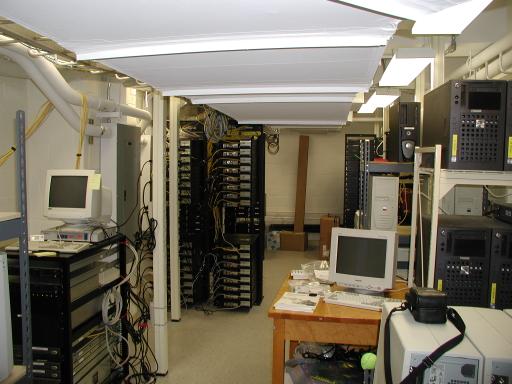|
|
Brahma
 |
 |
|
Figure 1. The various racks that make up the brahma clusters.
The nearest racks comprise the nano cluster. Then comes rama. The
champ cluster is in the racks in the far rear left of the room. Racks
on the right belong to other departments. |
Figure 2. On the shelves we have
the last two generations of the old brahma cluster (from the Intel
equipment grant), and the newer ganesh cluster. Several of the ganesh
cluster nodes were out of service at the time of this photo, probably
due to serious problems we had with room (mis)wiring. |
Brahma is the Duke University Physics Department's beowulf-style
parallel supercomputer cluster. More properly, Brahma is at this point
a collection of distinct clusters of various vintage, supported by
various groups. It can still be viewed, loosely, as a single cluster by
virtue of the fact that the computational resources represented are
liberally shared between the various contributing research groups so
that little of the resource is wasted in an idle state.
Brahma was funded by the Army
Research Office as part of its long running support for the research
of Brown and Ciftan. It was first "commissioned" in 1996, when its
first systems were purchased and configured as a "distributed parallel
supercomputer". The original systems used were dual Pentium Pro 200MHz
CPUs, interconnected by (then very new) 100 Mbps switched ethernet. A
more detailed history or photo tour of Brahma is available.
Although Brahma was not by any means the first linux-based PC
cluster, it was one of the first, and in particular one of the
first to be based on dual CPU systems (it ran the brand new linux 2.0.0
kernel out of Slackware on the original dual CPU nodes, which was the
first "production" kernel that could support SMP operation).
Consequently a fair bit of effort was expended just in dealing with SMP
issues, especially with networking, or endeavoring to get the Adaptec
SCSI bus to work correctly.
As time passed, more systems were added to the cluster, including
systems belonging to other theoretical physics research groups
interested in doing large scale computations, notably Berndt Mueller's
groups studying quark-gluon plasmas with a variety of means. At the
same time the physics department, which up to this time had been heavily
invested in Sun hardware running SunOS or Silicon Graphics hardware
running Irix, started implementing considerably less expensive commodity
hardware linux systems throughout the department. At first this was
done retaining a core of Sun servers, but as it became increasingly
clear that Linux-based servers were as stable and efficient if not more
stable and efficient than Solaris-based servers (especially in a
department scale LAN operation) the department gradually shifted over
into a linux-only configuration.
This, and an Intel Equipment grant received by the University in general
with the Duke Physics Department as one of the main participants,
permitted Brahma to scale up to well over 50 processors by around 2000.
This was "small" by the standards of the largest research clusters, but
nevertheless the cluster has been in nearly continuous use from its
inception in 1996 until today, with only very limited periods of idle
time or signficant instability. As a consequence, a lot of
research computation was performed, at a very high ratio of
benefit to cost.
 |
 |
|
Figure 3. Old pictures of the second and third generation of the
Brahma cluster, including the newer ganesh cluster (mounted on heavy
duty shelves on the right in the first picture. Shortly after this we
started using a more expensive but space efficient rackmount
configuration for all new cluster nodes, and are now phasing out
shelfmount nodes as they reach their end of life.
|
Duke Physics and the Brahma project has participated heavily on the
Beowulf list since shortly after its inception, at one point even
housing a mirror of the primary beowulf website when confusion at NASA
Goddard over funding and ownership issues temporarily shut it down. In
the earlier years it also participated heavily in linux SMP kernel
development, housing a mirror of the Linux SMP FAQ written by David
Mentre until it was finally converted into a proper HOWTO and moved onto
the Linux Documentation Project
website.
The Brahma website is also well-known as a resource site for would-be
beowulfers or linux-based cluster supercomputer builders. It houses the
only free (modified Gnu Open Publication License) Book on Beowulf Design, by Robert G. Brown
(who designed and constructed the original Brahma cluster and all its
various descendants and relatives in the department). It houses a
variety of other cluster resources, including software links, talks on parallel computing with commodity
off-the-shelf (COTS) compute clusters, a list of at least some vendors who market COTS components useful to
cluster computer builders or turnkey clusters or the like, and finally a
collection of useful cross-reference URL links
to other web-based resources that have been found useful in our own
cluster computing efforts.
At this point Brahma has grown tremendously. It now consists of the old
(soon to be retired) second generation nodes from the Intel grant as
well as third generation nodes from the Intel grant (the original
Pentium Pros are out of service). To these systems that are still the
brahma cluster, there have been
added the ganesh cluster (our first
cluster of Athlons), the rama
cluster, the champ cluster, the nano cluster, and soon we expect to add
a small shiva cluster.
All in all, the Brahma cluster has well over 150 CPUs and counting
(mostly in dual configurations of both Intel and Athlon processors) in
almost continuous use, housed in a dedicated cluster/server room
contributed by the University to help support the many participating
grant-funded research projects that use the Brahma resource. This room
also houses the physics department's servers and several clusters
belonging to other departments on the campus, as can be seen on the Duke Beowulf User's Group
website.
At this point, Brahma is only one of many clusters on Duke's campus,
which are only a very few of the many, many clusters in the United
States, which in turn are only a fraction of the clusters in active use
all over the world. From an idea shared by handful of visionaries at
Oak Ridge, at Nasa-Goddard, at a few Universities, beowulfs and compute
clusters have come of age. At this point, it is beyond any
that more high-performance computing compute cycles are provided and
used on linux-based compute clusters than on all other technologies
combined, with the margin widening every day and with no possible
competition on the horizon. A beowulf (or beowulf-like
open-source-based compute cluster or GRID) simply is the most
cost-effective way to cheaply obtain compute power for parallelizable
problems ranging from the simple to the very complex indeed.
|




